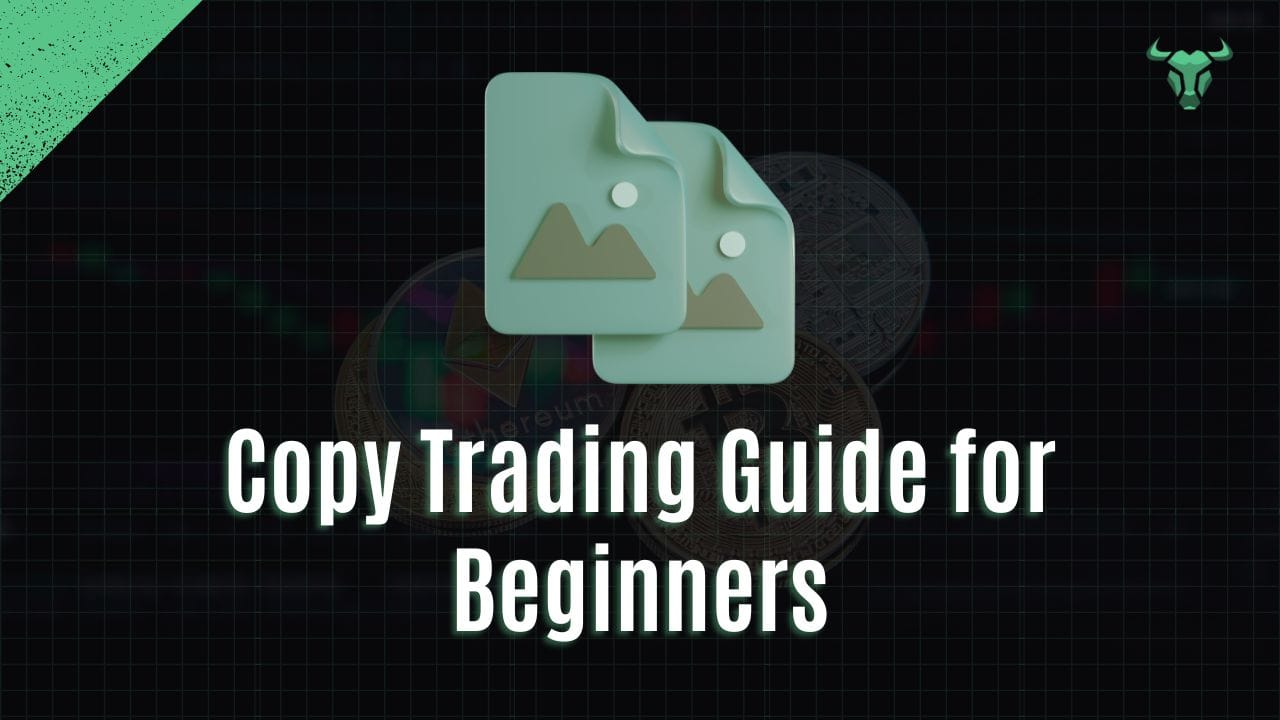Copy Trading Guide for Beginners

What Is Copy Trading?
Thinking about getting into trading but not sure where to start? You've probably heard about Copy Trading.
It sounds pretty straightforward, right?
Basically, you follow what other traders are doing. It can be a good way to learn the ropes or just add another strategy to your trading plan. We'll walk you through the basics so you can figure out if Copy Trading is for you.
Key Takeaways
- Copy Trading lets you automatically copy the trades of experienced traders. You don't need to make trades yourself.
- When you choose a platform, look at its features and how easy it is to use. BullX NEO, for example, is a multi-chain platform with a Telegram bot for trading.
- Picking the right trader to copy is important. Check their past results, but remember that past performance doesn't guarantee future success.
- Always manage your risk. Decide how much money you're willing to risk before you start copying trades.
- Be aware of trading fees and how they might affect your profits. Also, keep an eye on the traders you're copying and be ready to make changes if needed.
Understanding Copy Trading
So, you're curious about copy trading?
It's a pretty straightforward concept that's making waves in the investment world. Basically, it's a way to follow along with what other traders are doing in the market.
Instead of figuring out every single trade yourself, you can choose to automatically copy the actions of experienced traders. Think of it like having a trading assistant who's already in the trenches.
This method is available on many platforms, letting you replicate the moves of traders who have a track record you find appealing. It's a way to get involved without needing to be glued to the charts all day.
What is Copy Trading?
At its core, copy trading is an investment strategy where you automatically mirror the trades of another trader. When the trader you're following opens or closes a position, your account does the same.
It’s a way to participate in financial markets by essentially outsourcing the decision-making process to someone else.
You're not directly trading; you're copying someone who is. This can be a good starting point if you're new to trading or if you simply don't have the time to research and execute trades yourself.
Many brokers offer this feature, allowing you to connect your account to a chosen trader's strategy. You can find out more about how it works on various brokerage platforms.
How Does Copy Trading Work?
Copy trading operates through specialized trading platforms. You select a trader you want to follow, and then you allocate a portion of your capital to that trader.
The platform then automatically executes trades in your account that match the trades made by the trader you're copying, in proportion to the amount you've invested.
For example, if you allocate $100 to a trader and they open a trade using 10% of their capital, your account will open a similar trade using 10% of your allocated $100.
It’s important to understand that the performance of the copied trades directly impacts your account balance. The platform handles the technical side, ensuring that your trades align with the lead trader's actions.
Benefits of Copy Trading
There are several reasons why people are drawn to copy trading. For beginners, it offers a chance to learn by observing and participating in the market without the steep learning curve of developing trading skills from scratch.
It can save you a significant amount of time, as you don't need to conduct your own market analysis or constantly monitor positions.
Plus, it gives you access to strategies from traders who may have years of experience and a proven history. It's a way to potentially benefit from the market movements even if you're not an expert yourself.
Some of the key advantages include:
- Accessibility: You can start with relatively small amounts of capital.
- Time-Saving: Reduces the need for constant market monitoring.
- Learning Opportunity: Observe and learn from experienced traders.
- Diversification: Potentially spread your risk by copying multiple traders.
Copy trading can be a useful tool, but it's not a guaranteed path to profit. It's still trading, and that always involves risk. You're relying on the decisions of another person, and their performance can change.
Key Considerations for Copy Traders
When you start copy trading, there are a few important things to keep in mind. It's not just about picking someone who looks good on paper; you need to think about how you'll manage your money and what you're actually paying.
Risk Management Strategies
First off, let's talk about risk. You don't want to put all your eggs in one basket, right?
That applies here too.
Spreading your copied trades across different traders can really help. If one trader has a bad run, it won't wipe out your whole investment. Think about setting stop-loss orders on your copied trades, just like you would if you were trading yourself. This limits how much you can lose on any single trade.
It's also smart to decide beforehand how much of your total capital you're willing to risk on copy trading overall. Don't invest more than you can afford to lose.
Understanding Trading Fees
Platforms and traders often have fees. You'll see things like a spread, which is the difference between the buying and selling price, and sometimes a commission or a performance fee.
These costs can add up and eat into your profits. Make sure you know exactly what fees you're paying and how they're calculated.
A small percentage might not seem like much, but over time, it makes a difference. Always check the fee structure before you commit to copying a trader.
You can usually find this information in the trader's profile or on the platform's help pages. Understanding these costs is key to calculating your potential returns.

Evaluating Trader Performance
Looking at a trader's past performance is important, but it's not the whole story.
You want to see consistent results over a decent period, not just a few lucky trades. Check their win rate, their average profit per trade, and how often they experience drawdowns (periods where their account balance decreases).
Also, consider their trading style.
- Are they aggressive or conservative?
- Does it match your own comfort level with risk?
A trader with a high win rate but also very large losses on some trades might be riskier than someone with a slightly lower win rate but smaller, more consistent gains. Look at their trading history, not just the summary stats.
Advanced Copy Trading Techniques
Once you've got the basics down, you might want to try some more involved copy trading methods. It's not just about picking a trader and forgetting about it. You can actually get more out of it by being a bit more strategic.
Diversifying Your Copy Trades
Putting all your money into one trader or one type of asset is a risky move. Think about spreading your investments around.
You could copy a few different traders who specialize in different markets, like forex and crypto, or maybe traders with different strategies – some aggressive, some more conservative.
This way, if one area or one trader has a bad run, your whole investment isn't wiped out. It's like not putting all your eggs in one basket. You can find platforms that let you easily split your funds across multiple traders, which makes this kind of diversification pretty straightforward.
It's a good way to manage risk while still trying to catch different market opportunities.
Monitoring and Adjusting Your Portfolio
Your copy trading portfolio isn't a set-it-and-forget-it thing. You need to keep an eye on how the traders you're copying are doing.
- Are they sticking to their strategy?
- Has their performance changed recently?
Most platforms give you tools to track this. You might see that a trader you copied a few months ago isn't performing as well now, maybe because market conditions have shifted.
In that case, you might decide to reduce the amount you're copying them with, or even stop copying them altogether. It’s also smart to periodically review your overall allocation.
- Are you still comfortable with the risk level?
Maybe you want to increase your investment in a trader who's been doing really well. Making these adjustments helps keep your copy trading aligned with your goals and risk tolerance.
It’s about being proactive rather than just reactive. You can explore different copy trading strategies to see what fits best.
Leveraging Trading Analytics
To really get advanced, you'll want to look beyond just the trader's win rate.
Many platforms offer detailed analytics on trader performance. This can include things like profit factor, drawdown percentages, win/loss ratios over different periods, and even the types of assets they trade most frequently.
Understanding these metrics helps you make more informed decisions about who to copy and how much to allocate. For example, a trader with a high win rate but also very large drawdowns might be too risky for your preferences.
Conversely, a trader with a slightly lower win rate but very small drawdowns might be a more stable choice. Looking at the consistency of a trader's performance over time, rather than just recent wins, is often a better indicator of their long-term potential. You can also use these analytics to compare different traders side-by-side.
Being smart about copy trading means actively managing your investments, not just passively following. It involves understanding the data, spreading your risk, and being ready to make changes as needed.
This approach can lead to better results over time compared to just picking a popular trader and hoping for the best. It takes a bit more effort, but it's usually worth it.
Potential Pitfalls in Copy Trading
Copy trading can seem like a shortcut to profits, but it's not without its own set of challenges. You've got to be aware of what could go wrong so you don't get caught off guard. It's easy to get excited about someone else's winning streak, but remember, past performance isn't a crystal ball for future results.

Avoiding Over-Reliance on Others
It's tempting to just set it and forget it, letting the trader you're copying do all the work. But this can be a trap. If you stop thinking for yourself and just blindly follow, you might miss important market shifts or personal financial goals.
You're still responsible for your own money, even if someone else is making the trades you're copying.
Think of it like this: you wouldn't hand over your entire investment strategy to a friend without checking in, right?
The same applies here.
You need to stay involved, even if it's just a quick check-in on your portfolio.
Recognizing Market Volatility
Markets move. Sometimes they move fast and in ways nobody expects. A trader who's been successful for months can suddenly hit a rough patch when the market turns.
This isn't necessarily because they're bad traders; it's just how markets work. You need to be prepared for the fact that the trader you're copying might experience losses, and those losses will directly impact your account.
Don't get too comfortable during a winning streak, and don't panic sell when a drawdown happens. Understanding that volatility is part of trading is key.
Understanding Platform Risks
Every trading platform has its own set of rules and potential issues. Some platforms might have technical glitches that could affect your trades, or maybe their fees aren't as clear as they seem.
It's also possible that the platform itself isn't regulated in a way that fully protects you. Always do your homework on the platform you choose.
Look into their security measures, how they handle customer support, and what their terms and conditions really say.
A little bit of research upfront can save you a lot of headaches later.
Here are some platform-related things to watch out for:
- Hidden Fees: Some platforms might charge extra for withdrawals, inactivity, or even for copying specific traders.
- Execution Delays: Sometimes, trades might not be copied to your account instantly, leading to different entry or exit prices compared to the original trader.
- Platform Stability: Technical issues can occur, potentially disrupting your trading activity or the copying process.
- Regulatory Oversight: Ensure the platform is regulated by a reputable financial authority in your region.
Copy trading can seem like a shortcut to big profits, but it's not always smooth sailing. Sometimes, the traders you follow might make bad moves, or the market can change really fast, leaving you with losses. It's important to understand these risks before you jump in. Want to learn more about how to trade smarter and avoid common mistakes? Visit our website for helpful guides and tools.
Conclusion: Copy Trading
So, you've learned the basics of copy trading. It's a way to follow other traders and copy their moves, which can be helpful when you're just starting out. Remember, though, it's not a magic money-maker. You still need to do your homework and pick traders who seem to know what they're doing. Platforms like BullX NEO, with its Telegram bot and real-time data, can make this process easier, especially if you're trading different coins across various blockchains. Keep learning, start small, and don't put all your eggs in one basket. Good luck out there.
Frequently Asked Questions
What exactly is copy trading?
Copy trading is like having a pro trader do the trading for you. You pick a trader you like, and whatever they buy or sell, your account automatically does the same thing. It's a way to trade without needing to be an expert yourself.
How does copying trades actually work?
It’s pretty straightforward! You link your trading account to a platform that lets you follow other traders. Then, you choose who you want to copy. When they make a trade, your account copies it automatically. Think of it as a trading echo.
Can I make money with copy trading?
You can make money if the traders you copy make good trades. It’s a way to potentially earn profits from the market without having to spend hours learning to trade or watching charts all day. Plus, you can learn by watching what successful traders do.
How do I pick a good trader to copy?
You'll want to look at how well a trader has been doing over time, not just their recent wins. Check their past results, how much risk they take, and what other people say about them. A good trader usually has steady results, not just wild ups and downs.
What's the biggest risk I should know about?
It’s super important to only put in money you can afford to lose. Never copy trade with your rent money or savings you need. Also, don't put all your copy trading money with just one trader; spread it out to reduce the risk if one trader has a bad run.
Do I still need to pay attention when copy trading?
While copy trading can be easier, you shouldn't just forget about it. Keep an eye on the traders you follow and how your account is doing. Markets change, and sometimes you might need to stop copying a trader or adjust how much you're investing with them.
Want to learn more about BullX NEO? Check out these related guides:










